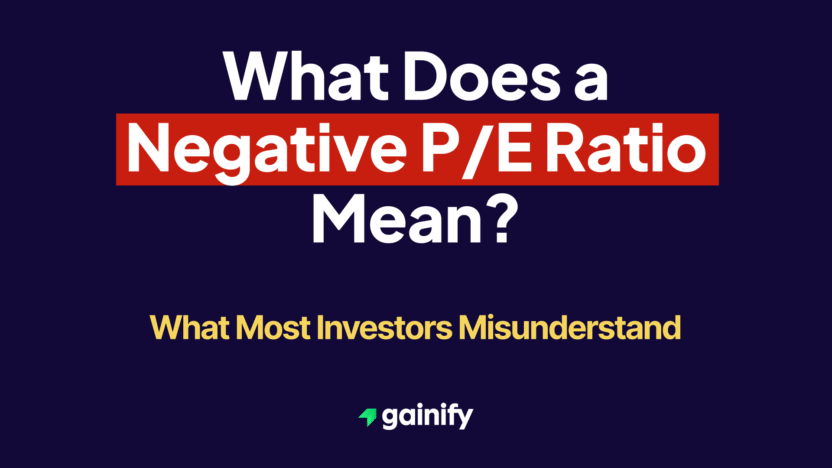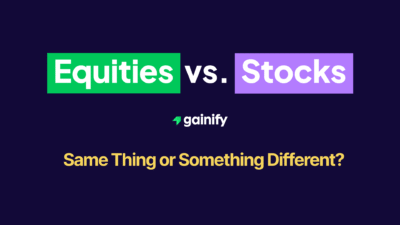Most investors tense up when they see a negative P/E ratio. It looks like a red flag and a sign that something is fundamentally wrong with the company. The instinct is to move on and find something safer.
But the truth is not that simple. A negative P/E can result from temporary factors such as one-off expenses, restructuring costs, or other non-recurring events that push earnings below zero. In other cases, it may reflect a company investing heavily for long-term growth rather than short-term profit.
Before drawing conclusions, it helps to understand what that negative number really represents and why even experienced investors often misread the signal.
What Causes a Negative P/E Ratio?
A negative P/E ratio happens when a company reports a net loss instead of a profit. The number itself is simple, but the reason behind it matters much more. Losses can tell very different stories depending on what caused them and how long they are likely to last.
Below are the most common causes of a net loss that can lead to a negative P/E ratio:
1. Growth and Expansion Costs
- Heavy investment in research and development (R&D)
- Spending on new product launches or entering new markets
- High marketing or customer acquisition expenses
- Increased staffing or infrastructure costs during scaling
2. Industry and Market Conditions
- Downturns in cyclical sectors such as airlines, energy, or construction
- Slower consumer demand caused by economic weakness or inflation
- Rising costs of materials, labor, or logistics
- Currency fluctuations that reduce international profits
3. One-Time or Non-Recurring Events
- Large asset write-downs or impairments
- Legal settlements or regulatory fines
- Restructuring charges or layoffs
- Mergers, acquisitions, or divestitures that create short-term accounting losses
4. Financial or Operational Issues
- Poor cost control or inefficiency in operations
- Declining sales or reduced pricing power
- High interest expenses from excessive debt
- Inventory losses or supply chain problems
5. External Shocks
- Natural disasters or global events that disrupt operations
- Political instability, trade disputes, or sanctions
- Changes in government policy or taxation that impact earnings
Not all of these causes are negative for investors. Some losses are temporary, especially those linked to investment or short-term events. Others reveal deeper problems in profitability or management. Understanding which type of loss a company is facing is the key to interpreting a negative P/E ratio accurately.
Is a Negative P/E a Bad Sign?
Not always.
A negative P/E ratio is not automatically a reason to avoid a stock, but it is a clear signal to look closer. In some situations, it can point to serious financial pressure, weak demand, or poor management. In others, it simply reflects a company that is investing heavily today to build stronger profits in the future.
The key is understanding the context. A short-term loss can be a normal part of a company’s growth cycle, while persistent or widening losses may reveal deeper structural problems. What matters is whether the business has a realistic path back to profitability and the balance sheet strength to get there.
There are situations when a negative P/E ratio is, indeed, a red flag. If a company has:
- Declining revenues and no roadmap for future growth
- High debt levels and poor access to capital
- Signs of poor management or lack of competitive advantage
- Negative cash flow over an extended period
…then the negative price-to-earnings signal should be taken seriously. In such cases, the stock may be priced for a worst-case scenario and could carry a real risk of bankruptcy if the losses persist. These situations require caution, especially during volatile market conditions or bear cycles in the entire industry.
What Should Investors Look for Instead?
If a P/E ratio is negative, smart investors don’t stop there. They analyze alternative valuation metrics like:
- Price-to-Sales (P/S) Ratio
- Enterprise Value-to-Revenue (EV/Rev)
- Price-to-Gross Profit (P/GP)
- Enterprise Value to EBITDA (EV/EBITDA)
Also, look for steady revenue growth, improving gross margins, and a clear path to profitability. Reviewing the company’s annual report, recent earnings updates, and long-term plans can help you see whether it’s moving in the right direction—whether the timeline is 3, 10, or even 30 years.
Investors should also consider forward earnings. If analysts expect the company to return to positive earnings in the future, then today’s negative P/E could actually point to a hidden opportunity worth exploring.
What Is the P/E Ratio, and Why It Matters
The P/E ratio or Price to Earnings ratio is a core valuation method used to compare a company’s share price to its earnings per share. It tells investors how much they are paying for every dollar of earnings the company generates.
P/E Ratio = Current Share Price / Earnings per Share
For example, if a stock trades at $100 and the EPS is $5, the P/E ratio is 20. This means investors are paying 20 times earnings to own a share.
But what happens when EPS is negative? The ratio itself becomes negative, creating what’s called a negative P/E ratio – a rare but telling signal in a company’s financial performance.
Final Thoughts: Should You Buy a Stock With a Negative P/E Ratio?
That depends on your investment strategy and risk tolerance.
If you’re a growth investor with a long-term outlook, a negative P/E ratio could signal a potential for growth, especially if the company has strong fundamentals, solid leadership, and a credible path toward profitability.
But if you’re following a value investing approach, in the style of Benjamin Graham, you’ll likely want to see positive earnings and more stable financial health.
At the end of the day, a negative P/E ratio is just one piece of the puzzle — not a verdict. Use it as a valuation signal, not a decision-maker.




